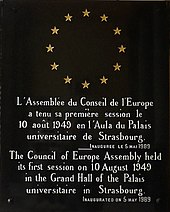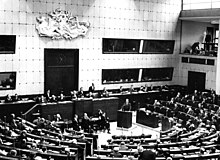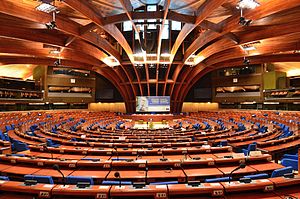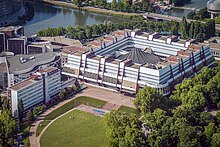Council of Europe
Conseil de l'Europe | |
 Logo | |
 | |
| Abbreviation | CoE |
|---|---|
| Formation | Treaty of London 1949 |
| Type | Regional intergovernmental organisation |
| Headquarters | Strasbourg, France |
| Location |
|
Membership |
|
Official languages | English, French Other working languages: German, Italian, Russian[1][2] |
Secretary General | Thorbjørn Jagland |
Deputy Secretary General | Gabriella Battaini-Dragoni |
President of the Parliamentary Assembly | Liliane Maury Pasquier |
President of the Committee of Ministers | Timo Soini |
President of the Congress | Jean-Claude Frécon |
| Website | www.coe.int |
The Council of Europe (CoE; French: Conseil de l'Europe, CdE) is an international organisation whose stated aim[3] is to uphold human rights, democracy and the rule of law in Europe.[4] Founded in 1949, it has 47 member states, covers approximately 820 million people and operates with an annual budget of approximately half a billion euros.[5]
The organisation is distinct from the 28-nation European Union (EU), although it is sometimes confused with it, partly because the EU has adopted the original European Flag which was created by the Council of Europe in 1955,[6] as well as the European Anthem.[7] No country has ever joined the EU without first belonging to the Council of Europe.[8] The Council of Europe is an official United Nations Observer.[9]
Unlike the EU, the Council of Europe cannot make binding laws, but it does have the power to enforce select international agreements reached by European states on various topics. The best known body of the Council of Europe is the European Court of Human Rights, which enforces the European Convention on Human Rights.
The Council's two statutory bodies are the Committee of Ministers, comprising the foreign ministers of each member state, and the Parliamentary Assembly, composed of members of the national parliaments of each member state. The Commissioner for Human Rights is an independent institution within the Council of Europe, mandated to promote awareness of and respect for human rights in the member states. The Secretary General heads the secretariat of the organisation. Other major CoE bodies include the European Directorate for the Quality of Medicines and the European Audiovisual Observatory.
The headquarters of the Council of Europe are in Strasbourg, France. English and French are its two official languages. The Committee of Ministers, the Parliamentary Assembly and the Congress also use German, Italian, Russian, and Turkish for some of their work.
Contents
1 History
1.1 Historic speeches at the Council of Europe
2 Aims and achievements
3 Institutions
3.1 Headquarters and buildings
4 Member states, observers, partners
5 Co-operation
5.1 Non-member states
5.2 European Union
5.3 United Nations
5.4 Non-governmental organisations
5.5 Others
6 Characteristics
6.1 Privileges and immunities
6.2 Symbol and anthem
7 Criticism and controversies
8 See also
9 References
10 Further reading
11 External links
History

Plaque commemorating the first session of the Council of Europe Assembly at Strasbourg University
Britain's wartime leader Sir Winston Churchill was the first to suggest the creation of "a Council of Europe" in a BBC radio broadcast on 21 March 1943, while the second world war was still raging. In his own words, he tried to "peer through the mists of the future to the end of the war", once victory had been achieved, and think about how to re-build and maintain peace on a shattered continent. Given that Europe had been at the origin of two world wars, the creation of such a body would be, he suggested, "a stupendous business". He returned to the idea during a well-known speech at the University of Zurich on 19 September 1946, [10][11] throwing the full weight of his considerable post-war prestige behind it.

Session of the Council of Europe's Parliamentary Assembly in the former House of Europe in Strasbourg in 1967. Willy Brandt, German Minister for Foreign Affairs, is speaking.
The future structure of the Council of Europe was discussed at a specific congress of several hundred leading politicians, government representatives and civil society in The Hague, Netherlands, in 1948. There were two schools of thought competing: some favoured a classical international organisation with representatives of governments, while others preferred a political forum with parliamentarians. Both approaches were finally combined through the creation of a Committee of Ministers (in which governments were represented) and a Consultative Assembly (in which parliaments were represented), the two main bodies mentioned in the Statute of the Council of Europe. This dual intergovernmental and inter-parliamentary structure was later copied for the European Communities, North Atlantic Treaty Organization and the Organization for Security and Co-operation in Europe.
The Council of Europe was founded on 5 May 1949 by the Treaty of London. The Statute was signed in London on that day by ten states: Belgium, Denmark, France, Ireland, Italy, Luxembourg, the Netherlands, Norway, Sweden and the United Kingdom. Three months later, on 10 August 1949, 100 members of the Council's Consultative Assembly, parliamentarians drawn from twelve nations (Turkey and Greece had by then joined the original ten founding members), met in Strasbourg for its first plenary session, held over 18 sittings and lasting nearly a month. They debated how to reconcile and reconstruct a continent still reeling from war, yet already facing a new East-West divide, launched the concept of a trans-national court to protect the basic human rights of every European citizen, and took the first steps towards what would in time become the European Union.
In August 1949, Paul-Henri Spaak of Belgium was elected president of the first session of the its assembly. Spaak helped develop a network of intergovernmental contacts in many fields, such as human rights, local government, education, culture, sports, and youth policy. However, the organization only played an advisory role, and was not nearly strong enough to achieve Spaak's long-term goals of European unification.[12]
Historic speeches at the Council of Europe
In 2018 an archive of all speeches made to the Parliamentary Assembly of the Council of Europe by heads of state or government since the Council of Europe's creation in 1949 appeared online, the fruit of a two-year project entitled "Voices of Europe". At the time of its launch, the archive comprised 263 speeches delivered over a 70-year period by some 216 Presidents, Prime Ministers, monarchs and religious leaders from 45 countries - though it continues to expand, as new speeches are added every few months.
Some very early speeches by individuals considered to be "founding fathers" of the European institutions, even if they were not heads of state or government at the time, are also included (such as Sir Winston Churchill or Robert Schuman). Addresses by eight monarchs appear in the list (such as King Juan Carlos I of Spain, King Albert II of Belgium and Grand Duke Henri of Luxembourg) as well as the speeches given by religious figures (such as Pope John Paul II) and several leaders from countries in the Middle East and North Africa (such as Shimon Peres, Yasser Arafat, Hosni Mubarak, Léopold Sédar Senghor or King Hussein of Jordan).
The full text of the speeches is given in both English and French, regardless of the original language used. The archive is searchable by country, by name, and chronologically.
Aims and achievements
Article 1(a) of the Statute states that "The aim of the Council of Europe is to achieve a greater unity between its members for the purpose of safeguarding and realising the ideals and principles which are their common heritage and facilitating their economic and social progress."[13] Membership is open to all European states who seek harmony, cooperation, good governance and human rights, accepting the principle of the rule of law and are able and willing to guarantee democracy, fundamental human rights and freedoms.
While the member states of the European Union transfer part of their national legislative and executive powers to the European Commission and the European Parliament, Council of Europe member states maintain their sovereignty but commit themselves through conventions/treaties (international law) and co-operate on the basis of common values and common political decisions. Those conventions and decisions are developed by the member states working together at the Council of Europe. Both organisations function as concentric circles around the common foundations for European co-operation and harmony, with the Council of Europe being the geographically wider circle. The European Union could be seen as the smaller circle with a much higher level of integration through the transfer of powers from the national to the EU level. "The Council of Europe and the European Union: different roles, shared values."[14] Council of Europe conventions/treaties are also open for signature to non-member states, thus facilitating equal co-operation with countries outside Europe.
The Council of Europe's most famous achievement is the European Convention on Human Rights, which was adopted in 1950 following a report by the Council of Europe's Parliamentary Assembly, and followed on from the United Nations 'Universal Declaration of Human Rights' (UDHR).[15] The Convention created the European Court of Human Rights in Strasbourg. The Court supervises compliance with the European Convention on Human Rights and thus functions as the highest European court. It is to this court that Europeans can bring cases if they believe that a member country has violated their fundamental rights and freedoms.
The various activities and achievements of the Council of Europe can be found in detail on its official website. The Council of Europe works in the following areas:

Building of the European Court of Human Rights
- Protection of the rule of law and fostering legal co-operation through some 200 conventions and other treaties,[16] including such leading instruments as the Convention on Cybercrime, the Convention on the Prevention of Terrorism, Conventions against Corruption and Organised Crime,[17][18][19] the Convention on Action against Trafficking in Human Beings, and the Convention on Human Rights and Biomedicine.[20]
CODEXTER, designed to co-ordinate counter-terrorism measures- The European Commission for the Efficiency of Justice (CEPEJ)
- Protection of human rights, notably through:
- the European Convention on Human Rights
- the European Committee for the Prevention of Torture
- the European Commission against Racism and Intolerance
- the Convention on Action against Trafficking in Human Beings[21]
- the Convention on the Protection of Children against Sexual Exploitation and Sexual Abuse[22]
- The Convention on preventing and combating violence against women and domestic violence.[23]
- social rights under the European Social Charter
- linguistic rights under the European Charter for Regional or Minority Languages
- minority rights under the Framework Convention for the Protection of National Minorities
Media freedom under Article 10 of the European Convention on Human Rights and the European Convention on Transfrontier Television
- the European Convention on Human Rights
- Protection of democracy through parliamentary scrutiny and election monitoring by its Parliamentary Assembly as well as assistance in democratic reforms, in particular by the Venice Commission.
- Promotion of cultural co-operation and diversity under the Council of Europe's Cultural Convention of 1954 and several conventions on the protection of cultural heritage as well as through its Centre for Modern Languages in Graz, Austria, and its North-South Centre in Lisbon, Portugal.
- Promotion of the right to education under Article 2 of the first Protocol to the European Convention on Human Rights and several conventions on the recognition of university studies and diplomas (see also Bologna Process and Lisbon Recognition Convention).
- Promotion of fair sport through the Anti-Doping Convention[24]
- Promotion of European youth exchanges and co-operation through European Youth Centres in Strasbourg and Budapest, Hungary.
- Promotion of the quality of medicines throughout Europe by the European Directorate for the Quality of Medicines and its European Pharmacopoeia.
Institutions
The institutions of the Council of Europe are:
- The Secretary General, who is elected for a term of five years by the Parliamentary Assembly and heads the Secretariat of the Council of Europe. Thorbjørn Jagland, the former Prime Minister of Norway, was elected Secretary General of the Council of Europe on 29 September 2009.[25] In June 2014, he became the first Secretary General to be re-elected, commencing his second term in office on 1 October 2014.[26]
- The Committee of Ministers, comprising the Ministers of Foreign Affairs of all 47 member states who are represented by their Permanent Representatives and Ambassadors accredited to the Council of Europe. Committee of Ministers' presidencies are held in alphabetical order for six months following the English alphabet: Turkey 11/2010-05/2011, Ukraine 05/2011-11/2011, the United Kingdom 11/2011-05/2012, Albania 05/2012-11/2012, Andorra 11/2012-05/2013, Armenia 05/2013-11/2013, Austria 11/2013-05/2014, and so on.[27]

Council's Parliamentary Assembly hemicycle
- The Parliamentary Assembly (PACE), which comprises national parliamentarians from all member states.[28] Adopting resolutions and recommendations to governments, the Assembly holds a dialogue with its governmental counterpart, the Committee of Ministers, and is often regarded as the "motor" of the organisation. The national parliamentary delegations to the Assembly must reflect the political spectrum of their national parliament, i.e. comprise government and opposition parties. The Assembly appoints members as rapporteurs with the mandate to prepare parliamentary reports on specific subjects. The British MP Sir David Maxwell-Fyfe was rapporteur for the drafting of the European Convention on Human Rights. Dick Marty's reports on secret CIA detentions and rendition flights in Europe became quite famous in 2006 and 2007. Other Assembly reports were instrumental in, for example, the abolition of the death penalty in Europe, highlighting the political and human rights situation in Chechnya, identifying who was responsible for disappeared persons in Belarus, chronicling threats to freedom of expression in the media and many other subjects.
- The Congress of the Council of Europe (Congress of Local and Regional Authorities of Europe), which was created in 1994 and comprises political representatives from local and regional authorities in all member states. The most influential instruments of the Council of Europe in this field are the European Charter of Local Self-Government of 1985 and the European Outline Convention on Transfrontier Co-operation between Territorial Communities or Authorities of 1980.[29][30]
- The European Court of Human Rights, created under the European Convention on Human Rights of 1950, is composed of a judge from each member state elected for a single, non-renewable term of nine years by the Parliamentary Assembly and is headed by the elected President of the Court. The current President of the Court is Guido Raimondi from Italy. Under the recent Protocol No. 14 to the European Convention on Human Rights, the Court's case-processing was reformed and streamlined. Ratification of Protocol No. 14 was delayed by Russia for a number of years, but won support to be passed in January 2010.[31]
- The Commissioner for Human Rights is elected by the Parliamentary Assembly for a non-renewable term of six years since the creation of this position in 1999. Since April 2012, this position has been held by Nils Muižnieks from Latvia.[32]
- The Conference of INGOs. NGOs can participate in the INGOs Conference of the Council of Europe. Since the [Resolution (2003)8] adopted by the Committee of Ministers on 19 November 2003, they are given a "participatory status".[33]
- The Joint Council on Youth of the Council of Europe. The European Steering Committee (CDEJ) on Youth and the Advisory Council (CCJ) on Youth of the Council of Europe form together the Joint Council on Youth (CMJ). The CDEJ brings together representatives of ministries or bodies responsible for youth matters from the 50 States Parties to the European Cultural Convention. The CDEJ fosters co-operation between governments in the youth sector and provides a framework for comparing national youth policies, exchanging best practices and drafting standard-setting texts. The Advisory Council on Youth comprises 30 representatives of non-governmental youth organisations and networks. It provides opinions and input from youth NGOs on all youth sector activities and ensures that young people are involved in the Council’s other activities.
- Information Offices of the Council of Europe in many member states.

European Directorate for the Quality of Medicines.
The CoE system also includes a number of semi-autonomous structures known as "Partial Agreements", some of which are also open to non-member states:
- The Council of Europe Development Bank in Paris
- The European Directorate for the Quality of Medicines with its European Pharmacopoeia
- The European Audiovisual Observatory
- The European Support Fund Eurimages for the co-production and distribution of films
- The Pompidou Group – Cooperation Group to Combat Drug Abuse and Illicit Trafficking in Drugs
- The European Commission for Democracy through Law, better known as the Venice Commission
- The Group of States Against Corruption (GRECO)
- The European and Mediterranean Major Hazards Agreement (EUR-OPA) which is a platform for co-operation between European and Southern Mediterranean countries in the field of major natural and technological disasters.
- The Enlarged Partial Agreement on Sport, which is open to accession by states and sport associations.[34]
- The North-South Centre of the Council of Europe in Lisbon (Portugal)
- The Centre for Modern Languages is in Graz (Austria)
Headquarters and buildings

Aerial shot of the Palais de l'Europe in Strasbourg

Council of Europe's Agora building
The seat of the Council of Europe is in Strasbourg, France. First meetings were held in Strasbourg's University Palace in 1949, but the Council of Europe soon moved into its own buildings. The Council of Europe's eight main buildings are situated in the Quartier européen, an area in the northeast of Strasbourg spread over the three districts of Le Wacken, La Robertsau and Quartier de l'Orangerie, where are also located the four buildings of the seat of the European Parliament in Strasbourg, the Arte headquarters and the seat of the International Institute of Human Rights.
Building in the area started in 1949 with the predecessor of the Palais de l'Europe, the House of Europe (demolished in 1977), and came to a provisional end in 2007 with the opening of the New General Office Building, later named "Agora", in 2008.[35] The Palais de l'Europe (Palace of Europe) and the Art Nouveau Villa Schutzenberger (seat of the European Audiovisual Observatory) are in the Orangerie district, and the European Court of Human Rights, the European Directorate for the Quality of Medicines and the Agora Building are in the Robertsau district. The Agora building has been voted "best international business center real estate project of 2007" on 13 March 2008, at the MIPIM 2008.[36] The European Youth Centre is located in the Wacken district.
Besides its headquarters in Strasbourg, the Council of Europe is also present in other cities and countries. The Council of Europe Development Bank has its seat in Paris, the North-South Centre of the Council of Europe is established in Lisbon, Portugal, and the Centre for Modern Languages is in Graz, Austria. There are European Youth Centres in Budapest, Hungary, and in Strasbourg. The European Wergeland Centre, a new Resource Centre on education for intercultural dialogue, human rights and democratic citizenship, operated in cooperation with the Norwegian Government, opened in Oslo, Norway, in February 2009.[37]
The Council of Europe has offices in Albania, Armenia, Azerbaijan, Bosnia and Herzegovina, Georgia, Moldova, Montenegro, Serbia, and Ukraine; information offices in Albania, Armenia, Azerbaijan, Bulgaria, Czech Republic, Estonia, Georgia, Hungary, Latvia, Lithuania, Moldova, Poland, Romania, Russian Federation, Slovakia, Slovenia, the Republic of Macedonia, and Ukraine; and a projects office in Turkey. All these offices are establishments of the Council of Europe and they share its juridical personality with privileges and immunities.
Due to persistent budgetary shortages, the Council of Europe is expected to cut down significantly the number of its activities, and thus the number of its employees, from 2011 on. This will notably affect the economy of the city of Strasbourg, where a total of 2,321 people (on 1 January 2010) are doing salaried work for the CoE. Most offices in foreign countries are expected to be closed as well.[38]
Member states, observers, partners
The Council of Europe was founded on 5 May 1949 by Belgium, Denmark, France, Ireland, Italy, Luxembourg, Netherlands, Norway, Sweden and the United Kingdom. Greece and Turkey joined three months later, and Iceland and West Germany the next year. It now has 47 member states, with Montenegro being the latest to join.
Article 4 of the Council of Europe Statute specifies that membership is open to any "European" State. This has been interpreted liberally from the beginning, when Turkey was admitted, to include transcontinental states (such as Georgia and Azerbaijan) and states that are geographically Asian but socio-politically European (such as Armenia and Cyprus).
Nearly all European states have acceded to the Council of Europe, with the exceptions of Belarus (human rights concerns), Kazakhstan (human rights concerns), and the Vatican City (a theocracy), as well as some of the territories with limited recognition.
Besides the status as a full member, the Council of Europe has established other instruments for cooperation and participation of non-member states: observer, applicant, special guest, and partner for democracy.
Co-operation
Non-member states
The Council of Europe works mainly through conventions. By drafting conventions or international treaties, common legal standards are set for its member states. However, several conventions have also been opened for signature to non-member states. Important examples are the Convention on Cybercrime (signed for example, by Canada, Japan, South Africa and the United States), the Lisbon Recognition Convention on the recognition of study periods and degrees (signed for example, by Australia, Belarus, Canada, the Holy See, Israel, Kazakhstan, Kyrgyzstan, New Zealand and the United States), the Anti-doping Convention (signed, for example, by Australia, Belarus, Canada and Tunisia) and the Convention on the Conservation of European Wildlife and Natural Habitats (signed for example, by Burkina Faso, Morocco, Tunisia and Senegal as well as the European Community). Non-member states also participate in several partial agreements, such as the Venice Commission, the Group of States Against Corruption (GRECO), the European Pharmacopoeia Commission and the North-South Centre.
Invitations to sign and ratify relevant conventions of the Council of Europe on a case-by-case basis are sent to three groups of non-member entities:[39]
- Non-European states: Algeria, Argentina, Australia, Bahamas, Bolivia, Brazil, Burkina Faso, Chile, China, Colombia, Costa Rica, Dominican Republic, Ecuador, El Salvador, Honduras, South Korea, Kyrgyzstan, Lebanon, Malaysia, Mauritius, Morocco, New Zealand, Panama, Peru, Philippines, Senegal, South Africa, Syria, Tajikistan, Tonga, Trinidad and Tobago, Tunisia, Uruguay, Venezuela and the observers Canada, Israel, Japan, Mexico, United States.
- European states: Kosovo, Kazakhstan, Belarus and the observer Vatican City.
- the European Community and later the European Union after its legal personality was established by the ratification of the EU's Lisbon Treaty.
